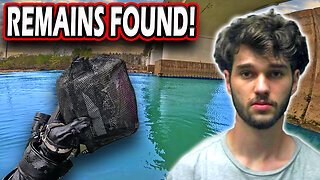Premium Only Content

On The Job: Grounding The Slab
There are many facets to putting in a new service to a building. Grounding is one of them! In this latest episode of Electrician U, Dustin talks a bit about the grounding necessary when installing a new service to a building.
🤘⚡️MEMBERSHIP⚡️🤘
JOIN ELECTRICIAN U - become a member and get:
FREE Continuing Education every year
FREE Practice Exams
FREE Monthly Video Courses
FREE Weekly Live Instructor-Led Classes
FREE Monthly Educational Newsletter
Premium Members-Only Content
Private Discord Channel
Monthly Members-Only Discord Chats
Sign up here --- https://www.electricianu.com/electrician-u-membership/
🎧🎹MUSIC AND VIDEO:🎹🎧
https://www.facebook.com/descantmv
🎬✍️ART AND ILLUSTRATION:✍️🎬
https://www.daverussoart.com
There is much more than conduit, wire, and a panel needed when putting a new service to a new or existing building. For the most part, the grounding path has not been established yet at the utility side of things. So, until we MAKE it, it simply is not there yet! Article 250 if the NEC covers grounding, and specifically, articles 250.50 & 250.52 are where we would find the requirements for grounding electrodes. The first of those two articles instruct us to install all the grounding electrodes that are present, while the latter of the two articles define the different points where we should ground.
The one Dustin talks about in the video is the Concrete Encased Electrode, more commonly known as the Ufer Ground. This is to be at least #4 in size, at least 20’ long, covered by at least 2” of concrete, and in direct contact with the earth. The NEC also instructs us to bond together the following if they are present on the building: Metal Underground Water Pipe, Metal In-Ground Support Structures, Ground Ring, Rod & Pipe Electrodes, Plate Electrodes, and any Other Local Metal Underground Systems or Structures (such as piping systems, underground tanks, and underground metal well casings). The NEC also instructs that the following items are NOT to be permitted as Grounding Electrodes: Metal Underground Gas Piping Systems-250.104B tells us to bond them if it’s likely the piping will become energized, Aluminum, and steel reinforcing structures for pools-which must still be bonded together, just not part of the Grounding Electrode System.
Another portion of the jobsite grounding Dustin talks about is the installation of ground rods at the light poles on the project. While there has been much debate about these ground rods being effective at light poles, and is not an NEC requirement to be installed at light poles, MOST job sites require them per the construction documents (plans and specs). So, if the particular job requires them to put them in, then we install them! Another thing to keep in mind is sizing and quantities of things that the ELECTRICAL ENGINEER has shown on the construction documents for us to install. Remember; it is THEIR name on those drawings, not ours. So, if they tell us to install a 4/0 copper somewhere, it is probably with good reason they are asking us to do it. We may just not understand why. We don’t want to install a LESSER product than the NEC requires but can certainly install MORE!!
In a nutshell, grounding of the electrical service requires us to use several different items if they are present in our installation, so make sure you reference your NEC code at article 250.50 & 250.52 to see what applies to your installation. It is also worthwhile to know your construction documents as these also generally show us where we should be grounding and to what points.
We hope this has been helpful in understanding the grounding system of an incoming new service. Is there a topic you would like to see discussed? Leave a comment in the comment section below and let us know! Please continue to follow Dustin and Electrician U as we are constantly adding new content to assist our followers in their electrical careers!
-
 0:56
0:56
Electrician U
1 year ago90° Drill Attachment!!! - What Hand Tools Are YOU Missing
5.62K1 -
 3:18:47
3:18:47
DLDAfterDark
9 hours ago $6.29 earnedDLD Live! What's The "best" PDW?? Considerations For Trunk/Truck Gun & Gats in Bags & Backpacks
33K7 -
 15:25
15:25
Exploring With Nug
20 hours ago $23.26 earnedBag of Phones Found While Searching For Missing Man In River!
93.9K28 -
 3:58:27
3:58:27
fuzzypickles168
9 hours agoLate Nite Jam Session - Rock Band 4 | Was: EA Sports WRC | 1 John 2:1-17
31.4K -
![Nintendo Switch It UP Saturdays with The Fellas: LIVE - Episode #13 [Mario Kart 8 Deluxe]](https://1a-1791.com/video/fww1/97/s8/1/1/g/A/z/1gAzy.0kob-small-Nintendo-Switch-It-UP-Satur.jpg) 3:33:38
3:33:38
MoFio23!
19 hours agoNintendo Switch It UP Saturdays with The Fellas: LIVE - Episode #13 [Mario Kart 8 Deluxe]
63.8K2 -
 23:24
23:24
MYLUNCHBREAK CHANNEL PAGE
20 hours agoDams Destroyed Turkey
109K95 -
 7:24:43
7:24:43
SpartanTheDogg
12 hours agoPro Halo Player
66.2K1 -
 11:29
11:29
Tundra Tactical
12 hours ago $3.84 earnedGEN Z Brit 3D Prints a WORKING Gun Pt.3!
63.4K6 -
 8:07:55
8:07:55
AdmiralSmoothrod
14 hours agoark ascended - its dino time again
39.4K2 -
 2:08:21
2:08:21
The Illusion of Consensus
9 days agoFormer FDA Official Dr. Philip Krause On White House Pressure To Approve Covid Vaccines at the FDA
74.9K61